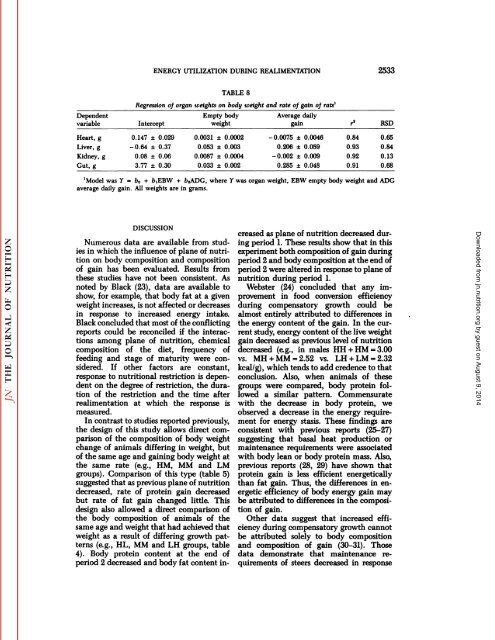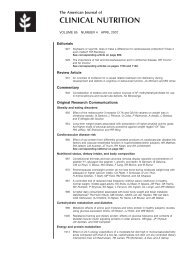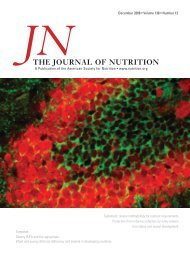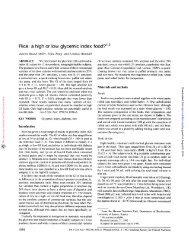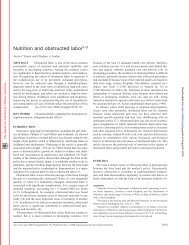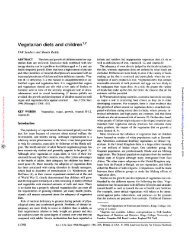Influence of Plane of Nutrition on Body Composition, Organ Size and ...
Influence of Plane of Nutrition on Body Composition, Organ Size and ...
Influence of Plane of Nutrition on Body Composition, Organ Size and ...
You also want an ePaper? Increase the reach of your titles
YUMPU automatically turns print PDFs into web optimized ePapers that Google loves.
ENERGY UTILIZATION DURING REALIMENTATION 2533DependentvariableHeart,gLiver,0.029-0.64 ±gKidney,0.370.08 ±gGut,0.063.77 ±gIntercept0.147 ±0.30Empty'Model was Y = b„+ b,EBWTABLESRegressi<strong>on</strong> <str<strong>on</strong>g>of</str<strong>on</strong>g> organ weights <strong>on</strong> body weight <strong>and</strong> rate <str<strong>on</strong>g>of</str<strong>on</strong>g> gain <str<strong>on</strong>g>of</str<strong>on</strong>g> rats1average daily gain. All weights are in grams.bodyweight0.00310.00020.053 ±0.0030.0087 ±0.00040.033 ±±0.002Averagedailygain-0.00750.00460.206 ±0.059-0.002 ±0.0090.285 ±±0.048r20.840.930.920.91BSD0.650.840.130.68+ b2ADG, where Y was organ weight, EBW empty body weight <strong>and</strong> ADGDISCUSSIONNumerous data are available from studies in which the influence <str<strong>on</strong>g>of</str<strong>on</strong>g> plane <str<strong>on</strong>g>of</str<strong>on</strong>g> nutriti<strong>on</strong> <strong>on</strong> body compositi<strong>on</strong> <strong>and</strong> compositi<strong>on</strong><str<strong>on</strong>g>of</str<strong>on</strong>g> gain has been evaluated. Results fromthese studies have not been c<strong>on</strong>sistent. Asnoted by Black (23), data are available toshow, for example, that body fat at a givenweight increases, is not affected or decreasesin resp<strong>on</strong>se to increased energy intake.Black c<strong>on</strong>cluded that most <str<strong>on</strong>g>of</str<strong>on</strong>g> the c<strong>on</strong>flictingreports could be rec<strong>on</strong>ciled if the interacti<strong>on</strong>s am<strong>on</strong>g plane <str<strong>on</strong>g>of</str<strong>on</strong>g> nutriti<strong>on</strong>, chemicalcompositi<strong>on</strong> <str<strong>on</strong>g>of</str<strong>on</strong>g> the diet, frequency <str<strong>on</strong>g>of</str<strong>on</strong>g>feeding <strong>and</strong> stage <str<strong>on</strong>g>of</str<strong>on</strong>g> maturity were c<strong>on</strong>sidered. If other factors are c<strong>on</strong>stant,resp<strong>on</strong>se to nutriti<strong>on</strong>al restricti<strong>on</strong> is dependent <strong>on</strong> the degree <str<strong>on</strong>g>of</str<strong>on</strong>g> restricti<strong>on</strong>, the durati<strong>on</strong> <str<strong>on</strong>g>of</str<strong>on</strong>g> the restricti<strong>on</strong> <strong>and</strong> the time afterrealimentati<strong>on</strong> at which the resp<strong>on</strong>se ismeasured.In c<strong>on</strong>trast to studies reported previously,the design <str<strong>on</strong>g>of</str<strong>on</strong>g> this study allows direct comparis<strong>on</strong> <str<strong>on</strong>g>of</str<strong>on</strong>g> the compositi<strong>on</strong> <str<strong>on</strong>g>of</str<strong>on</strong>g> body weightchange <str<strong>on</strong>g>of</str<strong>on</strong>g> animals differing in weight, but<str<strong>on</strong>g>of</str<strong>on</strong>g> the same age <strong>and</strong> gaining body weight atthe same rate (eg., HM, MM <strong>and</strong> LMgroups). Comparis<strong>on</strong> <str<strong>on</strong>g>of</str<strong>on</strong>g> this type (table 5)suggested that as previous plane <str<strong>on</strong>g>of</str<strong>on</strong>g> nutriti<strong>on</strong>decreased, rate <str<strong>on</strong>g>of</str<strong>on</strong>g> protein gain decreasedbut rate <str<strong>on</strong>g>of</str<strong>on</strong>g> fat gain changed little. Thisdesign also allowed a direct comparis<strong>on</strong> <str<strong>on</strong>g>of</str<strong>on</strong>g>the body compositi<strong>on</strong> <str<strong>on</strong>g>of</str<strong>on</strong>g> animals <str<strong>on</strong>g>of</str<strong>on</strong>g> thesame age <strong>and</strong> weight that had achieved thatweight as a result <str<strong>on</strong>g>of</str<strong>on</strong>g> differing growth patterns (e.g., HL, MM <strong>and</strong> LH groups, table4). <strong>Body</strong> protein c<strong>on</strong>tent at the end <str<strong>on</strong>g>of</str<strong>on</strong>g>period 2 decreased <strong>and</strong> body fat c<strong>on</strong>tent increased as plane <str<strong>on</strong>g>of</str<strong>on</strong>g> nutriti<strong>on</strong> decreased during period 1. These results show that in thisexperiment both compositi<strong>on</strong> <str<strong>on</strong>g>of</str<strong>on</strong>g> gain duringperiod 2 <strong>and</strong> body compositi<strong>on</strong> at the end <str<strong>on</strong>g>of</str<strong>on</strong>g>period 2 were altered in resp<strong>on</strong>se to plane <str<strong>on</strong>g>of</str<strong>on</strong>g>nutriti<strong>on</strong> during period 1.Webster (24) c<strong>on</strong>cluded that any improvement in food c<strong>on</strong>versi<strong>on</strong> efficiencyduring compensatory growth could bealmost entirely attributed to differences inthe energy c<strong>on</strong>tent <str<strong>on</strong>g>of</str<strong>on</strong>g> the gain. In the current study, energy c<strong>on</strong>tent <str<strong>on</strong>g>of</str<strong>on</strong>g> the live weightgain decreased as previous level <str<strong>on</strong>g>of</str<strong>on</strong>g> nutriti<strong>on</strong>decreased (e.g., in males HH + HM = 3.00vs. MH + MM = 2.52 vs. LH + LM = 2.32kcal/g), which tends to add credence to thatc<strong>on</strong>clusi<strong>on</strong>. Also, when animals <str<strong>on</strong>g>of</str<strong>on</strong>g> thesegroups were compared, body protein followed a similar pattern. Commensuratewith the decrease in body protein, weobserved a decrease in the energy requirement for energy stasis. These findings arec<strong>on</strong>sistent with previous reports (25-27)suggesting that basal heat producti<strong>on</strong> ormaintenance requirements were associatedwith body lean or body protein mass. Also,previous reports (28, 29) have shown thatprotein gain is less efficient energeticallythan fat gain. Thus, the differences in energetic efficiency <str<strong>on</strong>g>of</str<strong>on</strong>g> body energy gain maybe attributed to differences in the compositi<strong>on</strong> <str<strong>on</strong>g>of</str<strong>on</strong>g> gain.Other data suggest that increased efficiency during compensatory growth cannotbe attributed solely to body compositi<strong>on</strong><strong>and</strong> compositi<strong>on</strong> <str<strong>on</strong>g>of</str<strong>on</strong>g> gain (30-31). Thosedata dem<strong>on</strong>strate that maintenance requirements <str<strong>on</strong>g>of</str<strong>on</strong>g> steers decreased in resp<strong>on</strong>seDownloaded from jn.nutriti<strong>on</strong>.org by guest <strong>on</strong> August 9, 2014


